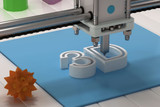How is 3D Printing Technology enhancing the Advertising Industry?
3D printing, or additive manufacturing, is the process of using digital files to create three- dimensional, solid objects. 3D printers work by reading these files and creating a solid object by laying down each material layer after another until the object is completed. The technology is relatively new, but it is still being rapidly used to create customized goods in various sectors, including medical, consumer electronics, aviation, and architecture.
However, the applications continue beyond there. Experiential marketers are researching and using innovative technologies to incorporate 3D printing into their next advertising campaign. This is one reason why many marketers turn to 3D printing to ignite a spark of excitement in viewers and their target demographics. Some brands like Coca-Cola, VW, Nokia, Belvita, and DVV are already ahead of the curve, by integrating additive manufacturing in marketing to gain an advantage.
Currently, many brands need lots of money to invest in a 3D printing machine, but this needs to be seen as investment, like when purchasing commercial signs. As a result, many businesses opt for finished 3D-printed marketing materials from B2B companies instead.
However, there are many benefits to 3D printing. So, let;s look at how it has enhanced the advertising industry.
Innovative way to introduce products
Launching a new product can be incredibly daunting because you're not entirely sure of the nature of the responses you will receive. Additionally, if you're a startup with limited capital, taking on a substantial working capital business loan to fund manufacturing and marketing is not ideal. This will only make sense once you receive desired feedback for the particular marketing method.
The best part about additive manufacturing is you can create prototypes and launch promotional campaigns on a small scale. After that, you can monitor responses and move on to the next step. The initial feedback you receive from launching the prototype can assist you in aiding product development.
You won't have to spend a ton of capital on creating moulds to launch new products. As a result, you can save money by using 3D printers to build prototypes before investing in large-scale marketing.
Low cost materials
Experts predict that 3D printing will be the next big thing in advertising. One reason is the technology's ability to create marketing materials for shop displays and other promotional items at a small price. 3D printings allow you to build intricate displays to decorate your store and make you stand out without investing an arm and a leg. This strategy is even implemented in the construction and real estate industry.
Customization and User Interaction
The most impactful marketing potential 3D printing possesses is customization. Whenever you wish to modify or tweak the color of a certain product, know that this is now very much possible and a reality that has been implemented in many brands. 3D printing lets customers get creative with their product design to suit their preferences.
Providing customization can also help to encourage user interaction, create marketing buzz and enable users to design some new products or work on perfecting old ones. This will push people to participate and create long-term loyalty to your brand. With a budget, you can print designs from participants and provide samples or perform the printing onsite in a crowd.
Comfort of inspection
Customers are more satisfied if they know their product's quality and realistic appearance, especially from a brand they have never purchased from before. Customers want to see and touch before they invest. This technology will significantly improve marketing by providing 3D-printed physical samples so consumers can inspect the product before they buy. This is particularly ideal for online sellers of high-ticket items, allowing them to send potential customer samples. This is a more cost-effective approach to encourage people to purchase your goods.
Some examples of 3D printing in advertisement
Coca-Cola Israel introduced its new Mini Bottles, where the producer started a contest that created consumer mini-me's using 3D printing. A mobile app allowed them to design mini- versions of themselves, and winners were rewarded with a trip to the Coca-Cola factory. There they could 3D-print their mini-mes.
Another example is how Volkswagen also promoted its Polo with the help of 3D printing in Denmark. People were allowed to take control of the 3D printer to create the original car model via a website along with their versions. 40 ideas were 3D-printed and displayed in Copenhagen.
3D printing allows for a new innovative way to launch your products. This is especially true when the response you might receive is unpredictable. It also allows customers to customize products to their liking, encourages more customer interaction and helps to build customer loyalty. The cost of materials is relatively low and allows you to create stunning intricate displays to decorate your physical store. Finally, your customers get the comfort of inspecting a product prototype before purchasing it. This will revolutionize online shopping and marketing entirely.
We hope this article proved insightful and has shown you the advertising potential for 3D printing technology. Thank you for reading!
Recent Posts
-
Best Computer Screens for Home and Office
Computer display screens, often referred to simply as monitors, have undergone a remarkable evolutio …27th Dec 2023 -
Unleashing Creativity Down Under: The Best 3D Printing Filament Options in Australia
Australia has become a hub for creativity and innovation, and 3D printing is no exception. With an …3rd Jun 2023 -
How is 3D Printing Technology enhancing the Advertising Industry?
3D printing, or additive manufacturing, is the process of using digital files to create three- dime …8th May 2023

 FREE SHIPPING ON ORDER OVER $75
FREE SHIPPING ON ORDER OVER $75
 LOYALTY PROGRAM
LOYALTY PROGRAM
 SHIPPING WORLDWIDE
SHIPPING WORLDWIDE



